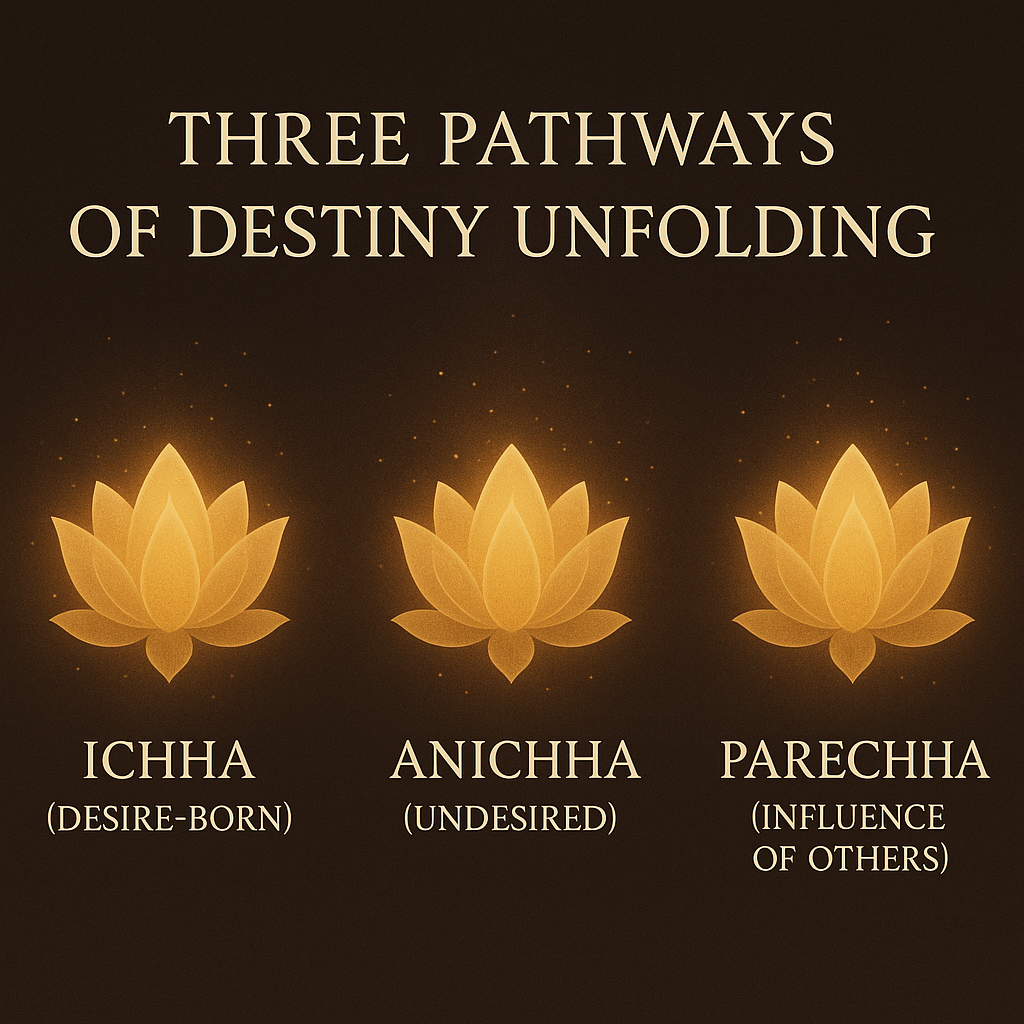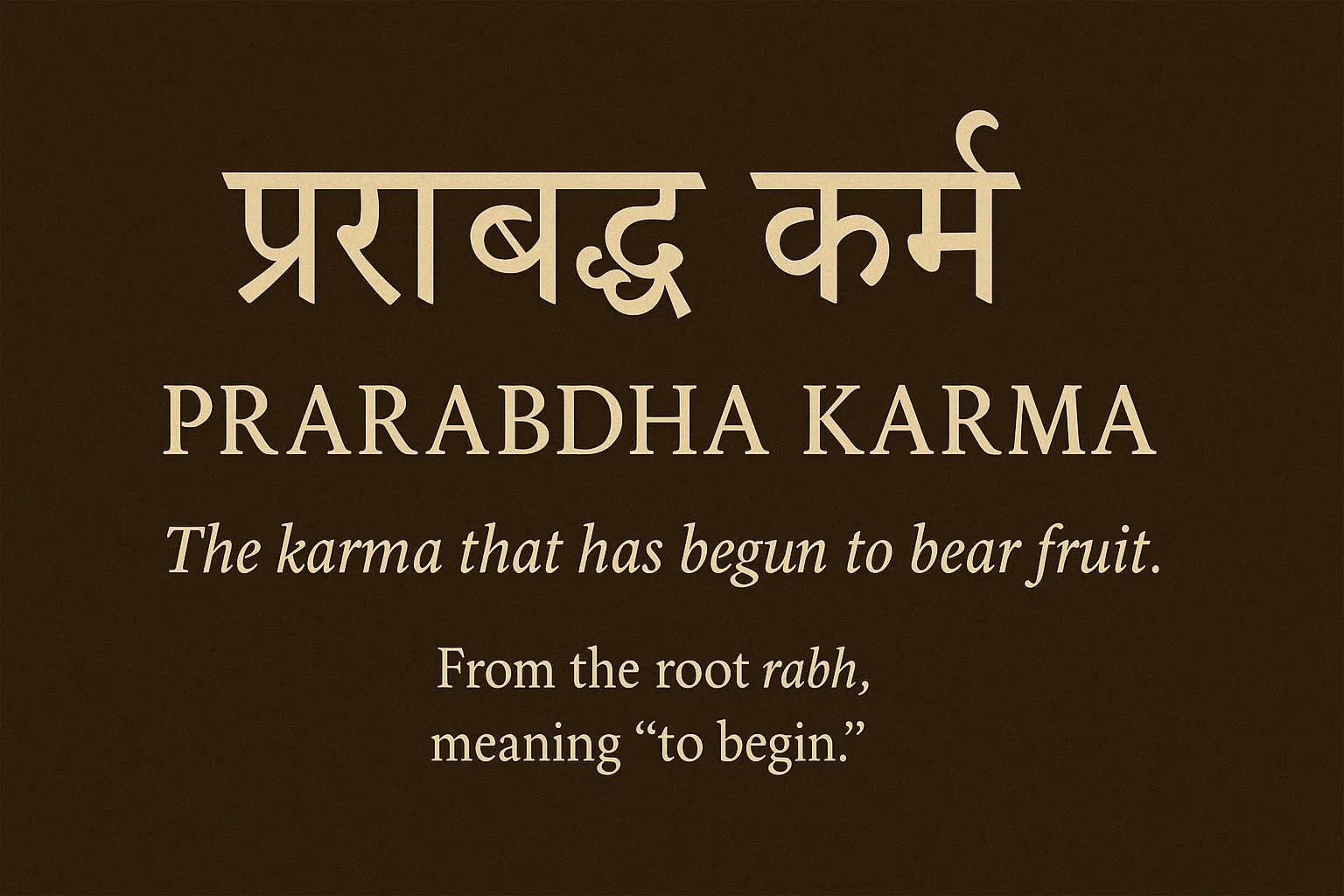Have you ever wondered why you were born into the family you were born into, the sound or a bit unhealthy health that you have, or why you have your specific physical form?
You didn’t consciously choose them, so is it all random?
In Hinduism, this is not so random.
The family you were born into, your physical form, your initial health, the country you were born into, your capacity to earn wealth with fewer obstacles or full of obstacles, and a potential healthy/unhealthy marriage, and so on, are all a part of your ‘Prarabdha Karma’.
In our previous blog, we learned that the future karma being created by our current actions is known as Agami Karma, and the collection of all your karmas throughout all of your previous lifetimes is known as the Sanchita Karma.
In this blog, let’s explore what Prarabdha is, how it compares to sanchita, and the other 3 different types of karma in hinduism, and how awareness can help you rise above it.
Prarabdha Karma Meaning
The word “Prarabdha” (प्रारब्ध) comes from the Sanskrit root “rabh,” meaning “to begin” or “to commence.”
Hence, in literal terms, Prarabdha Karma means “the karma that has begun to bear fruit.”
While Agami Karma is the Karma that is creating fruits that will begin in the future (usually next lives), Prarabdha is the portion of your accumulated past actions (Sanchita Karma) that will manifest in your present life.
Just like an arrow that has already left the bow, Prarabdha Karma cannot be recalled or stopped midair. It must complete its course.
The Bhagavad Gita (4.17) says:
“Gahana karmaṇo gatiḥ”
“The path of karma is deep and mysterious.”
And Prarabdha is that mystery in action. The unseen hand behind your birth, body, family, health, and major life experiences.
What is Prarabdha Karma?
To understand Prarabdha, let’s briefly recall the four different types of Karma in hinduism:
- Sanchita Karma: The total accumulated karma from all past lives, the vast storehouse of our karma.
- Prarabdha Karma: The portion of that storehouse currently playing out in your present life.
- Kriyamana Karma: The actions you perform now in this life.
- Agami Karma: The future karma being formed by your present actions.
Of all these 4 Karma, Prarabdha is the most influential karma in your present life.
It decides where and when you are born, the parents you get, the challenges you face, and even the opportunities that come your way.
While Kriyamana and Agami karmas can be altered through conscious action, Prarabdha Karma is already in motion and cannot be escaped easily.
Prarabdha Karma Examples
Think of someone born into a musical family who, from childhood, displays immense natural talent. That gift, though refined through effort, comes from past-life impressions now flowering as positive Prarabdha Karma.
Similarly, another person may work hard yet repeatedly face financial obstacles or keep facing chronic illness.
This isn’t punishment; it’s Prarabdha balancing past causes that are now ripening into effect.
In both cases, it’s not random; it’s karma bearing its positive and negative fruits.

What are the Three Types of Prarabdha Karma?
According to Vedantic tradition, Prarabdha is divided into three categories based on desire and choice:
- Ichha-Prarabdha (इच्छा प्रारब्ध): The karma that arises from one’s own desires. These are experiences we consciously or subconsciously wanted.
- Anichha-Prarabdha (अनिच्छा प्रारब्ध): The karma we did not wish for, yet must undergo due to past actions. Illness, accidents, or sudden loss often belong here.
- Parechha-Prarabdha (परेच्छा प्रारब्ध):The karma that arises due to the desires or influence of others (collective or social destiny).
Even great saints experience the results of Prarabdha until liberation. As Ramana Maharshi said,
“The body itself is born of Prarabdha. One must live through it until it exhausts itself.”
How Do I Know My Prarabdha Karma?
You cannot see Prarabdha directly, but you can figure out the patterns, such as maybe recurring health issues, emotional triggers, family dynamics, or even effortless blessings; they all often reflect Prarabdha Karma at work.
Vedic Astrology (Jyotisha) is the tool to observe your prarabdha through your birth chart (Janma Kundali).
However, please note that astrology only mirrors tendencies, not a fixed destiny. You always have free will.
Astrology shows the wider terrain, and your awareness determines how you walk it.
Prarabdha Karma vs Sanchita Karma
The difference between sanchita karma and prarabdha karma is that sanchita karma is everything that could happen; prarabdha Karma is what is happening right now in this life based on that sanchita karma.
- Sanchita Karma is the collection of all the karma of all the lives that you have lived (it might be a collection of karma of 100s of lives you have lived, and stores both good and bad karma).
- Prarabdha is the active portion of that sanchita karma allocated for this life.
In this life, you’re doing many actions (both good and bad), this is Kriyamana Karma, this Kriyamana Karma creates Agami Karma, the current actions that you’re doing right now will bear the fruit in the future (usually in the next lives).
When this life ends, your Agami Karma gets added to your Sanchit Karma, and from that pool, a new Prarabdha is drawn for the next birth.
How to Get Rid of Prarabdha Karma?
Here is a subtle truth: Prarabdha Karma cannot be avoided; it must be lived out.
But it can lose its binding power when we live our lives with awareness and realization.
Let’s say you keep attracting emotionally unavailable partners.
You always pour your heart into the relationship, give your all, but your efforts aren’t reciprocated.
This isn’t a coincidence; it’s your Prarabdha Karma at play.
It’s showing you a pattern: the tendency to neglect yourself for others, to place someone else’s happiness above your own self-worth and love.
Two things can happen here.
You might keep asking, “Why does this keep happening to me?”, without realizing that these recurring relationships are mirrors reflecting your own pattern of self-neglect.
Or you might be aware clearly that you’re neglecting yourself, you’re putting others first before you yourself, and that you are repeating the same pattern.
The latter one, that moment of awareness, is the completion of your Prarabdha.
You cannot escape your Prarabdha; you were destined to meet a partner who triggers this very lesson.
But what happens after the trigger is your free will.
If you recognize your pattern early, and choose to act with awareness, that is, realizing that you come first, realizing that self-love comes first, and that efforts must be mutual. You start valuing yourself, set boundaries, and walking away from neglect, your prarabdha is completed.
Now you stop attracting the same kind of partner because the inner tendency (the seed of that karma) has already dissolved, and even if you do, you’re quick to be aware and not invest your energy in it in a way that affects your emotional health.
This is rising above your prarabdha by completing it.
Other paths to reduce the burden of prarabdha include the same ways that we have discussed in other karma series blog, engaging in bhakti, living dharmically, or following karma yoga, dhyana yoga, and so on.
To explore more about these 4 types of Karma and how they each come into play and how we can rise above it all, explore my main blog on ‘Karma in Hinduism’.
FAQs
What is Prarabdha Karma meaning in English?
Prarabdha means “the portion of karma to be experienced in this life allocated from your past lives’ collection of karma known as sanchita karma”.
Which karma cannot be changed?
Prarabdha Karma cannot be changed or escaped; it must be lived through. However, with awareness and wisdom, prarabdha can be completed or bent. When Prarabdha is completed, it no longer affects you.
Which house shows Prarabdha Karma?
In astrology, Prarabdha is often seen through the 6th, 8th, and 12th houses representing debts, transformation, and liberation.
Prarabdha Karma is part of which karma?
Prarabdha Karma is a portion of Sanchita Karma, the total accumulated karma of all your past lives.
Is marriage Prarabdha Karma?
Yes, marriage and major life areas (such as your overall health, wealth potential) are considered results of Prarabdha Karma, formed by past-life actions.
What is the significance of suffering in Prarabdha?
The suffering is to teach your a lesson, a lesson to grow from your old tendencies. With awareness, you realize that prarabdha karma isn’t about making you suffer, but rather to learn, to overcome your tendencies, and to grow from them.
The Wisdom Beyond Karma
Prarabdha reminds us that not everything in life is random. Yet, not everything is unchangeable either.
Through right action, free will, and awareness, Prarabdha can be completed or bent in a way that favors you, leading you closer to freedom from the wheel of karma.
Om Namo Nārāyaṇāya.

Leave a Reply